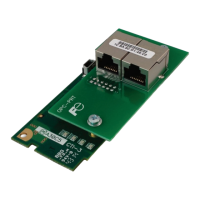iv) For the Destination Element, select “data_array[50]”.
d) “Communication” tab settings (refer to Figure 71):
Figure 71: Setting the Communication Path
i) Enter the Path to the interface c ard. A typical path is formatted as
“Local_ENB,2,target_IP_address”, where:
• Local_ENB is the name of the 1756-ENBx module in the local chassis (we
named ours “EIP” in section 9.2.10),
• 2 is the Ethernet port of the 1756-ENBx module in the local chassis, and
• target_IP_address is the IP address of the target node.
In our example, this path would be entered as “EIP,2,192.168.16.163”.
ii) If “Cache Connections” is enabled (checked), the connection remains open after
transmission. If disabled (unchecked), the connection is opened before and closed
after every transmission. For efficiency, it is recommended to enable “Cache
Connections”.
e) Click “OK” to close the MSG Configuration dialog. At this stage, MainRoutine should look like
Figure 72.
Figure 72: MainRoutine
5) Assign a tag to the XIO element.
a) Double-click on the XIO element located to the left of the MSG block. In the drop-down box,
double-click on the “connection.EN” field. Refer to Figure 73. This configuration causes the
MSG instruction to automatically retrigger itself when it completes. While this is acceptable
for the purposes of this example, it can produce high network utilization. In actual practice, it
may be desirable to incorporate additional logic elements to allow triggering the MSG
instruction at a specific rate or under specific conditions.

